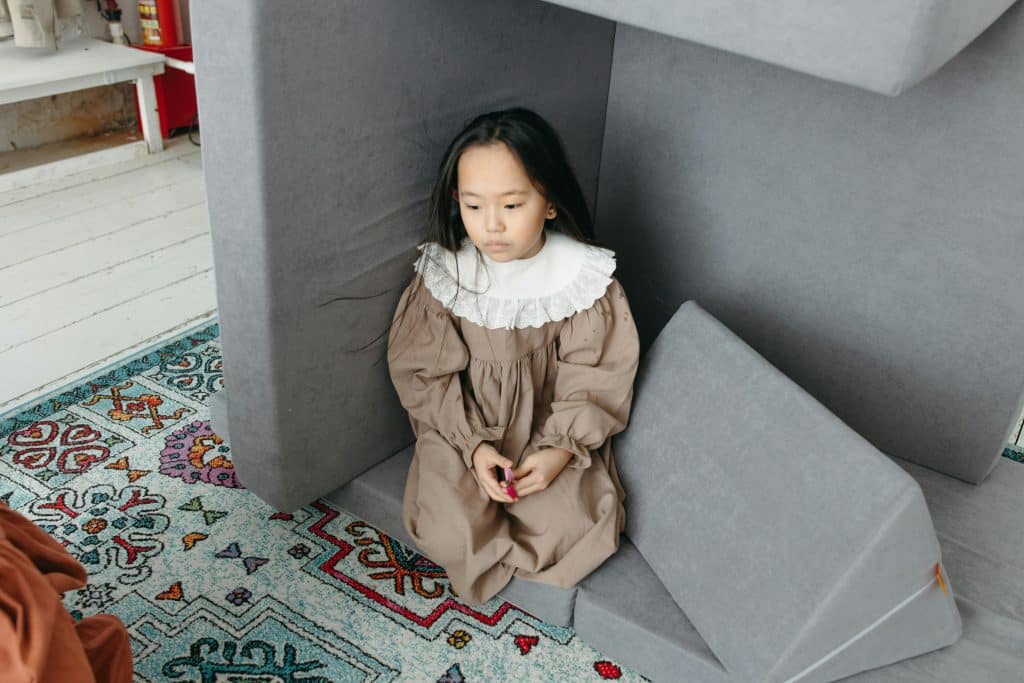As a licensed occupational therapist who works with neurodivergent kids every day, I’ve seen firsthand the challenges that children with sensory processing disorder (SPD) face. Can’t you picture your kids splashing around at the water park, only to have one of them suddenly curl up on the bench, covering their ears and shutting their eyes tight? I know I can. Sensory processing issues can make even the most fun activities feel overwhelming for these kids and I am here to teach you how to help a child with sensory processing disorder.
Table of Contents
Advocate for Support
The first step in helping a child with SPD is to ensure they have the support they need at home and school. I always encourage parents to talk to their child’s teacher, school support staff, and pediatrician about the specific sensory needs and challenges their child is facing.
Teachers and school staff may not always be familiar with sensory processing disorders, so educating them and working together to create an environment that meets the child’s needs is important. This could involve things like providing a quiet space for the child to take breaks, allowing them to use fidget toys or other sensory tools, and modifying classroom activities to reduce sensory overwhelm.
Pediatricians can also play a key role in identifying and addressing sensory processing issues. They can refer the child to an occupational therapist for a comprehensive evaluation and treatment plan. OTs are experts at assessing a child’s sensory needs and developing customized strategies to help them thrive.

Develop an Exit Strategy
One of the most important things we can do for a child with SPD is to help them develop coping strategies for when they feel overwhelmed. I always work with my clients to create an “exit strategy” – a plan for the child to remove themselves from a stressful situation and find a way to calm down.
This might involve teaching the child to take deep breaths, listen to soothing music, or go to a designated “calm down” space. It’s also helpful to role-play different scenarios and practice the exit strategy so the child feels empowered and knows what to do when they feel sensory overload.
Establishing this exit strategy ahead of time can make a huge difference in helping the child feel safe, secure, and able to manage their sensory needs. It’s like giving them a superpower to navigate the world around them.

Read more: Is SPD Neurodivergent ?
Teach Coping Strategies
Besides an exit strategy, it’s crucial to equip children with SPD with a toolbox of coping strategies they can use daily. This is where visual schedules, social stories, and other evidence-based techniques can be conducive.
Visual schedules, for example, can help a child with SPD understand the flow of their day and prepare for transitions. Social stories can explain sensory stresses or inappropriate sensory-seeking behaviors clearly and relatable and teach the child more appropriate coping strategies.
Build Custom Printable Visual Schedules
Is your child having trouble managing their routines? Here’s a free visual schedule builder. Goally’s custom tool allows you to create printable personalized schedules that motivate your child to focus on their tasks. Perfect for morning, homework, and bedtime routines, this free visual schedule builder is easy to use and will help your child reach their full potential.
Click below to make your CUSTOM printable visual schedule! 👇
Other calming techniques I often recommend include deep breathing exercises, progressive muscle relaxation, and sensory-based activities like weighted vests or pressure garments. The key is to work closely with the child to identify what works best for them and make these strategies a regular part of their routine.
Create a Sensory Diet
One of the most powerful ways to support a child with SPD is to work with an occupational therapist to develop a customized “sensory diet.” This is a detailed schedule of therapies, activities, and environmental modifications tailored to the child’s sensory needs.
For example, a sensory diet might include regular deep-pressure massage, opportunities for heavy work activities like climbing or pushing/pulling, and access to fidget toys or other sensory tools throughout the day. It might also involve adaptations to the home environment, such as creating a quiet, low-stimulation space, reducing visual clutter, or incorporating weighted blankets or pressure garments.
a sensory diet aims to provide the child with the sensory input they crave in a regulated, healthy way, helping them stay calm, focused, and able to engage in daily activities. It’s a game-changer for so many kids with SPD.
Goally | Apps To Support Child Development
Looking for fun ways to help your child learn life skills? Try Goally! The Goally tablet comes with award-winning learning apps and video classes to help kids develop the skills they need to become independent with FUN & evidence-based practices.

Our apps teach executive function, language, emotional regulation, finger dexterity skills, and more.
As your child develops new skills, you can increase the difficulty level of the tasks in the app to challenge and motivate them even further. This helps your child grow and progress at their own pace, while also keeping them engaged and excited about their development.

Helping a child with sensory processing disorder can feel daunting. Still, these amazing kids can thrive with the right strategies and support. By advocating for their needs, developing an exit strategy, teaching coping skills, and creating a customized sensory diet, we can empower children with SPD to navigate the world around them and find joy in everyday moments. Remember, every child is different, so working closely with your child’s healthcare team is important to find what works best. But with patience, creativity, and a little bit of sensory know-how, you can make a world of difference in the life of a child with SPD.
Helpful Resources
- Understood.org – Understanding Sensory Processing Disorder
- University of Washington – Sensory Processing Disorder
- American Occupational Therapy Association – Sensory Processing Disorders
FAQ’s About How to Help a Child With Sensory Processing Disorder
What is sensory processing disorder?
Sensory processing disorder (SPD) is a condition where the brain has trouble receiving and responding to information that comes in through the senses.
What are some signs of SPD in children?
Signs include being oversensitive to sounds, lights, textures; poor motor skills; anxiety in crowded environments; fidgeting.
How can a sensory diet help a child with SPD?
A sensory diet is a customized schedule of activities and accommodations that helps provide the sensory input a child needs to stay focused and regulated.
What role do occupational therapists play for SPD?
Occupational therapists evaluate sensory needs and create treatment plans, including sensory diets and coping strategies tailored to each child.
Why is it important to teach coping strategies for SPD?
Coping strategies like breathing exercises help kids self-regulate when feeling overwhelmed by sensory input, promoting independence.
Emily is a seasoned blog writer for Goally, leveraging her extensive background in child psychology and special education to provide valuable insights and resources for parents. Her commitment to understanding and addressing the unique needs of these children, combined with her expertise in educational strategies, makes her a credible and empathetic voice for families.






